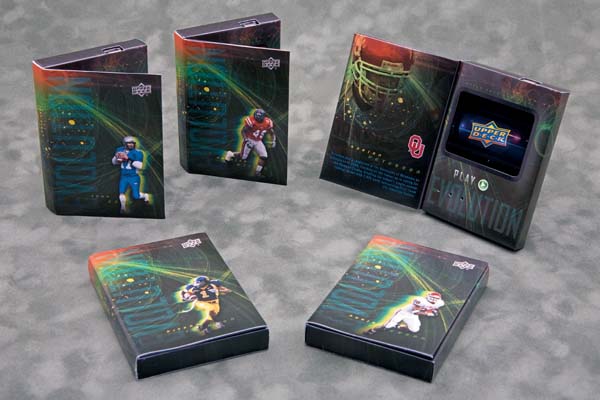I’m a big proponent for innovation in the hobby. I get excited by ideas that are truly new. Unfortunately, more often than not, it’s one manufacturer taking a successful idea from another and slapping a serial number or sticker autograph on it and calling it “the next great thing.”
With separate announcements from both Panini and Upper Deck that cards featuring hi-def video clips are on the way, it looks like there’s a budget for innovation again. But are cards with video the way to go?

Up front, I’m not going to take much of a yay or nay stand on video cards simply because they’re not out there yet. It’s way too early to dismiss the idea. It’s also too soon to call it a savior for a lagging hobby.
Combining cards and video seems like an obvious way to go. As a society we seem to be obsessed with video clips about anything and everything, good and bad. The more random the better it seems. So take that idea of a YouTube video and somehow get it onto a trading card. That seems to be the premise of these announcements, highlighting the fact that everything from clips to players signing the cards can be captured now in card form on an HD screen.
But here’s the problem: we’re beyond static media. How many times can you watch an athlete sign a card? How many times can you watch them score the same touchdown? Should these video cards be limited in what they can offer in the number of videos they can offer, I have serious doubts of their long-term viability.
The techno wizards may be working on some sort of way to update or change the content, which would be much cooler. It would make me turn the thing on more than three times – if content updates were simple. But then it raises an already obvious question: can video cards truly be regarded as cards? Or are they licensed media players that happen to have a hobby distribution model?
Looking at the images Upper Deck released, the first thing that came to mind for me was that they were almost the size of a pack of smokes or gum. I’m open to different dimensions, but at first appearances, they didn’t strike me as being cards. Again, until I see something more than a mock-up, I’ll reserve judgement.

Given the size limitations (which also bring up distribution questions), could there be other ways to offer video without being totally cumbersome? The answer to me seems a lot more straight forward: reserve a corner on the back of a card for a QR code that can be scanned with a smart phone and send the user to an interactive site that has limitless potential to be updated and interacted with. A simple graphic would also keep trading cards looking and feeling like trading cards.
If you’re not familiar with QR codes, they look like pixelated bar codes that smart phone reader apps can decode and send the user to a website. From a user’s perspective, I find it simple to use. It really adds to a magazine article that can be enhanced with a video clip. The potential uses on cards are numerous: an evolving video stream, a player page that updates stats and achievements, a trading page where you could directly connect with collectors who might be looking for that card to finish their set. Essentially, by linking the card to a page, the potential is much bigger than what a few minutes of video can hold.
There’s other, more tangible benefits to QR codes as well. From a manufacturing perspective, a QR code is a very cheap innovation. Developing and maintaining a complex website might be pricey so maybe try it out on a small scale at first to test the level of interaction. Or partner with the leagues and players to link directly to existing pages, at least for a launch.
From a collecting perspective, QR codes would keep cards looking like cards. They’re simply an additional bit of ink so it’s not like they’re going to destroy the nostalgic aesthetic.
We’re still a couple years away from know whether or not these video card things are another fad to be put in the Card Museum next to cards in a can or CD-ROM sets or if they truly will be “the next big thing” like all the hype is claiming them to be.










